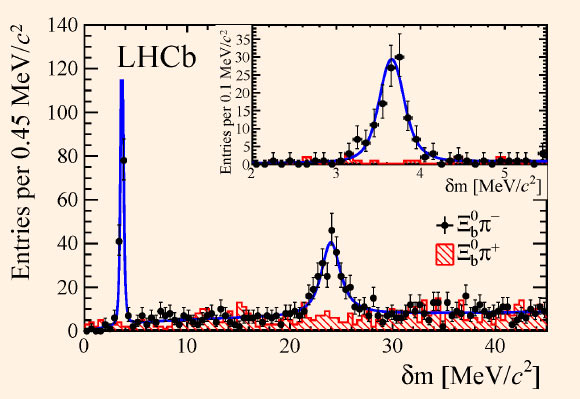Physicists at CERN’s Large Hadron Collider beauty (LHCb) experiment today announced the discovery of two new baryon particles, named Ξb’- and Ξb*-.

LHCb result shows strong evidence of the existence of two new particles the Ξb’- (first peak) and Ξb*- (second peak), with the high-level confidence of 10 sigma. Image credit: LHCb experiment / CERN.
Like the protons that the Large Hadron Collider (LHC) accelerates, the new particles are baryons made from three quarks (beauty, strange and down quark) bound together by the strong force.
They were predicted to exist by the quark model but had never been seen before. A related particle, Ξb*0, was discovered by scientists at CERN’s CMS experiment in 2012.
Thanks to the heavyweight b quarks, Ξb’- and Ξb*- are more than six times as massive as the proton.
But the particles are more than just the sum of their parts: their mass also depends on how they are configured. Each of the quarks has an attribute called ‘spin.’
In the Ξb’- state, the spins of the two lighter quarks point in opposite directions, whereas in the Ξb*- state they are aligned. This difference makes the Ξb*- a little heavier.
“This is a very exciting result. Thanks to LHCb’s excellent hadron identification, which is unique among the LHC experiments, we were able to separate a very clean and strong signal from the background. It demonstrates once again the sensitivity and how precise the LHCb detector is,” said team member Dr Steven Blusk of Syracuse University in New York.
“Nature was kind and gave us two particles for the price of one. The Ξb’- is very close in mass to the sum of its decay products: if it had been just a little lighter, we wouldn’t have seen it at all using the decay signature that we were looking for,” said team member Dr Matthew Charles of the CNRS’s LPNHE laboratory at Paris VI University.
As well as the masses of these particles, the physicists studied their relative production rates, their widths – a measure of how unstable they are – and other details of their decays.
The result shows the extraordinary precision that LHCb is capable of: the mass difference between the Ξb’- and the Ξb0 is measured with an uncertainty of 0.02 MeV/c2, less than four one-millionths of the total Ξb0 mass.
By observing these particles and measuring their properties with such accuracy, LHCb physicists make a stringent test of models of nonperturbative Quantum Chromodynamics (QCD), part of the Standard Model of particle physics.
Theorists will be able to use these measurements as an anchor-point for future predictions.
“If we want to find new physics beyond the Standard Model, we need first to have a sharp picture. Such high precision studies will help us to differentiate between Standard Model effects and anything new or unexpected in the future,” said team member Dr Patrick Koppenburg from Nikhef Institute in Amsterdam.
The discovery is detailed in a paper submitted to the journal Physical Review Letters (arXiv.org preprint).
_____
R. Aaij et al. 2014. Observation of two new Ξ−b baryon resonances. Phys. Rev. Lett, submitted for publication; arXiv:1411.4849







